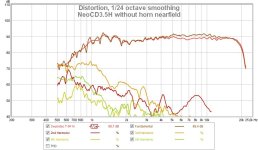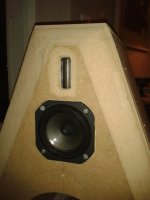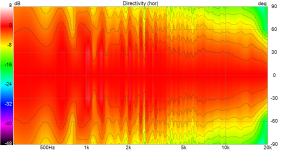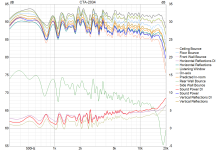I used the DXT tweeters in a project, but was never happy with the sound. I tried several iterations of the XO, but nothing made me happy even if measurements looked pretty good.
I bought them because of the even directivity, matching acoustic center offset (with a cone mid), and distortion performance.
I bought them because of the even directivity, matching acoustic center offset (with a cone mid), and distortion performance.
Hificompass has step response of DXT which shows the diffraction ripples that fluid mentions.

I have listened to a pair of MarkK ER18DXT for 16 years without problems... Spl deviations in tweeter range are caused by cabinet edge diffractions! (I forgot to measure both L/R rotations, the tweeter is offset, so only one cheek is measured despite graph shows both)
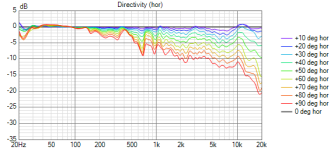
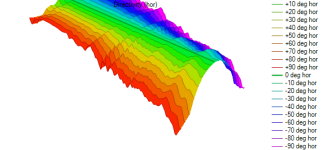
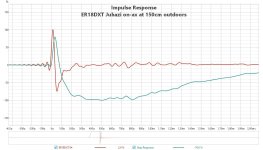

I have listened to a pair of MarkK ER18DXT for 16 years without problems... Spl deviations in tweeter range are caused by cabinet edge diffractions! (I forgot to measure both L/R rotations, the tweeter is offset, so only one cheek is measured despite graph shows both)




Last edited:
I think that thecripplr is not diffraction but a heavy cone breakup at some 26kHz. Typical for alu cones.
Yes the jagged step is due to the large HF peak, visible in almost all metal drivers.I think that thecripplr is not diffraction but a heavy cone breakup at some 26kHz. Typical for alu cones.
Nice to know, my measurements are 48kHz sample rate, so limit is just below DXT's peak
Perhaps very low distortion makes it sound dull for some listeners??

https://www.speakerdesign.net/seas/tweeters/dxt/dxt_tweeter.html
https://www.audioexcite.com/?page_id=2386
MarkK's original https://web.archive.org/web/2014101...tics.org/projects_gallery/ER18DXT/ER18DXT.htm
Perhaps very low distortion makes it sound dull for some listeners??
https://www.speakerdesign.net/seas/tweeters/dxt/dxt_tweeter.html
https://www.audioexcite.com/?page_id=2386
Hi everyone,
I’ve started a new build project called “Prestigious Two – Monitor DXT” and currently I’m in the fine tuning, listening test and final measurement project stage.
This time I’ve used less expensive driver units from the “Seas Prestige line” The mid-woofer used is the U16RCY/P, which has a woven polypropylene cone and phase plug. The mid-woofer has a smooth extended frequency response with a controlled roll-off, without nasty cone break-ups. For its size it has a large radiating surface (99cm²) and the bass performance is very good.
A variant of this...
I’ve started a new build project called “Prestigious Two – Monitor DXT” and currently I’m in the fine tuning, listening test and final measurement project stage.
This time I’ve used less expensive driver units from the “Seas Prestige line” The mid-woofer used is the U16RCY/P, which has a woven polypropylene cone and phase plug. The mid-woofer has a smooth extended frequency response with a controlled roll-off, without nasty cone break-ups. For its size it has a large radiating surface (99cm²) and the bass performance is very good.
A variant of this...
Hi.
I,m interested in building Mark K,s er18dxt. It looks like a perfect candidate for my next build.
However, the tweeter placement is off set. Now, I understand why this is but my "mental" disorder just can't deal with the visual.. . 🙄
How bad impact would it be to center the tweeter on the baffle?
Thanx and best regards.
JZ
I,m interested in building Mark K,s er18dxt. It looks like a perfect candidate for my next build.
However, the tweeter placement is off set. Now, I understand why this is but my "mental" disorder just can't deal with the visual.. . 🙄
How bad impact would it be to center the tweeter on the baffle?
Thanx and best regards.
JZ
Last edited:
On axis that diffraction sum in the impulse response should show as one ripple, not many. But it could be discussed if such phenomena are audible. For me, I only would trust an ABX test.
It's not diffraction, it's the breakup of the diaphragm that so affects the speaker's impulse. Compare the impulse of the beryllium or aluminum Bliesma T25 and T34 with the diamond version...Hificompass has step response of DXT which shows the diffraction ripples that fluid mentions.
The DXT is an excellent tweeter, but a little bitchy to integrate.
It reacts different to the baffle geometry than usual tweeters; typical enclosure edge reflection artifacts around ~3kHz are reduced due to the increased directivity in this range. But at higher frequencies the directivity gets wider than usual caused by the intentional diffraction effect of the DXT lens, so the tweeter reacts very sensitive to the baffle geometry in the upper treble. Best solution is a very small baffle around the tweeter like realized for the Heissmann DXT-MON or for the ASR Directiva r2 concept. Very wide baffle like Grimm LS1 works also well, as in a speaker I build with a 30cm wide baffle.
With "usual" baffles the DXT might work not so well as you expect from common tweeters.
Here is a contour plot from EAC of the Kii three, you can see the narrowing around 7kHz caused by the baffle and an overemphasis at 13kHz or so caused by probably the upper enclosure edge:

This speaker from me has similar geometry, and resulting similar behavior:


Further, the sensitivity of the DXT decreases from 95dB in the lower treble to 86dB in the upper treble which must be EQed. This is a significant limitation for the use in a passive 3-way. If you need system sensitivity >86dB you must live with a decreasing treble FR >10kHz that might sound a bit dull or take another tweeter...
P.S.: Give the DXT a passive parallel notch in series to fight the 27kHz dome ringing. 0,015mH || 1,5uF || 0,82uF works exactly at least for my samples driven by FA123 tweeter channel.
It reacts different to the baffle geometry than usual tweeters; typical enclosure edge reflection artifacts around ~3kHz are reduced due to the increased directivity in this range. But at higher frequencies the directivity gets wider than usual caused by the intentional diffraction effect of the DXT lens, so the tweeter reacts very sensitive to the baffle geometry in the upper treble. Best solution is a very small baffle around the tweeter like realized for the Heissmann DXT-MON or for the ASR Directiva r2 concept. Very wide baffle like Grimm LS1 works also well, as in a speaker I build with a 30cm wide baffle.
With "usual" baffles the DXT might work not so well as you expect from common tweeters.
Here is a contour plot from EAC of the Kii three, you can see the narrowing around 7kHz caused by the baffle and an overemphasis at 13kHz or so caused by probably the upper enclosure edge:
This speaker from me has similar geometry, and resulting similar behavior:
Further, the sensitivity of the DXT decreases from 95dB in the lower treble to 86dB in the upper treble which must be EQed. This is a significant limitation for the use in a passive 3-way. If you need system sensitivity >86dB you must live with a decreasing treble FR >10kHz that might sound a bit dull or take another tweeter...
P.S.: Give the DXT a passive parallel notch in series to fight the 27kHz dome ringing. 0,015mH || 1,5uF || 0,82uF works exactly at least for my samples driven by FA123 tweeter channel.
Last edited:
DXT is the tweeter that gets very polarized reviews.
Few years ago I did DXT two way with SB17CAC. Large facets of the front baffle provided excellent tweeters measured response, and if I recall well, the distortion was ok too. However, it sounded very dull, lacking detail. I consulted this with the local DIYers and they reported the same. Also hifi friends visiting hifi shows had quite the same reservations when they heard this tweeter in Kii, Grimm, etc.
I spent ages tweeking the crossover. Nothing helped. So I swapped for TW29DN and voilla, problem solved. TW29BN measured actually worse (no WG). The argument that the lack of the distortion = sounds dull is wrong. TW29DN, and also TW29TXN, TW29BN, 9800, 7000, 7100, T25B, T34S, 6600 I I could go on (as all of those and a lot of others I used and made a projects with) and some of them in waveguides, they all have very low distorion as well, yet they sound good, they do not lack the detail, and they do not sound dull.
T34A, Scan Speak 9800, as good and known Alu tweeters, sound much better. They have their character, though they sound vivid (as the opposite of dull) and very detailed and if implemented properly, they are one of the best sounding tweeters.
I think DXT can be made to sound quite ok in same implementations (and amps etc.). But once you have experience with other tweeters, you hear the difference. Of course, we all hear differently and our preferences differ. It is just that vivid, airy, detailed yet not fatiquing, full bodied, not cold, not analytical - this all DXT is NOT.
As @hifijim already worked and still can listen to TW29TXN and TW29BN in WG, going with DXT now would be step back in the sound quality. And I do not assume SQ is what we all are after and what is our motivation for DIY, especially if the midrange is M74S.
It is possible Seas made minor updates of the DXT during the years it has been on the market so sonic character minght have changed a bit though.
Measure, listen, make your own experience, that all is what counts in this hobby. What works for one does not have to work for other.

Few years ago I did DXT two way with SB17CAC. Large facets of the front baffle provided excellent tweeters measured response, and if I recall well, the distortion was ok too. However, it sounded very dull, lacking detail. I consulted this with the local DIYers and they reported the same. Also hifi friends visiting hifi shows had quite the same reservations when they heard this tweeter in Kii, Grimm, etc.
I spent ages tweeking the crossover. Nothing helped. So I swapped for TW29DN and voilla, problem solved. TW29BN measured actually worse (no WG). The argument that the lack of the distortion = sounds dull is wrong. TW29DN, and also TW29TXN, TW29BN, 9800, 7000, 7100, T25B, T34S, 6600 I I could go on (as all of those and a lot of others I used and made a projects with) and some of them in waveguides, they all have very low distorion as well, yet they sound good, they do not lack the detail, and they do not sound dull.
T34A, Scan Speak 9800, as good and known Alu tweeters, sound much better. They have their character, though they sound vivid (as the opposite of dull) and very detailed and if implemented properly, they are one of the best sounding tweeters.
I think DXT can be made to sound quite ok in same implementations (and amps etc.). But once you have experience with other tweeters, you hear the difference. Of course, we all hear differently and our preferences differ. It is just that vivid, airy, detailed yet not fatiquing, full bodied, not cold, not analytical - this all DXT is NOT.
As @hifijim already worked and still can listen to TW29TXN and TW29BN in WG, going with DXT now would be step back in the sound quality. And I do not assume SQ is what we all are after and what is our motivation for DIY, especially if the midrange is M74S.
It is possible Seas made minor updates of the DXT during the years it has been on the market so sonic character minght have changed a bit though.
Measure, listen, make your own experience, that all is what counts in this hobby. What works for one does not have to work for other.
Last edited:
And in lies the problems presented by horns and waveguides and the abrupt phase shift mechanically induced………you’re either sensitive to it or your not……there’s a distinct love hate line in the sand debate always brewing in hifi circles…….A large tweeter with a tall dome like the T35 and TW034 behaves quite differently to a larger dome that is quite flat like the SB Satori's. Within reason the taller the dome the less directive it is at high frequencies.
The DXT creates directivity by introducing intentional diffraction. It has a property that I would try and avoid when desigining a waveguide, that the listening window responses are consistent but messy. They cross over each other at different frequencies and this is the inevitable consequence of diffraction from a sudden change in curvature.
I have never owned a DXT so I have no idea what they sound like, a couple of people whose audio opinions I place some weight in do not like them.
……and it’s personal…..and for good reason……all the measurments and sims in the world cannot account for an individuals preference. Group think all you like……add in the shared personal experiences of others to create a suggestive bias and there you have it……..an entire segment of HiFi enthusiasts who will always hate waveguides and horns…….just because.
This word…..diffraction…….seems to be responsible for everything that is unpleasant but cannot be accounted for.
FWIW, I built Marks ER back in the day……..a great sounding speaker at volume…..I attributed it to the low odd order HD and limited directivity control……held its own in a pretty large room. DXT did its job and didn’t stand out on its own…..like a good 2 way should.
Perhaps the dullness reported with DXT comes from "too even" directivity added with low H3? We are used to have dome-typical rising on-axis response associated with rising DI. With DXT this peak is missing, so eg. cymbals with lots of harmonic overtones are not so crispy. As well it is rare to see as smooth response above 10kHz with add-on waveguides.
With DXT serial cap (or dsp) correction should go very high up to 15kHz.
OK, how about stealing wg+tweeters from JBL LSR305 actives? 😊 https://www.erinsaudiocorner.com/loudspeakers/jbl_305pmk2/
My MkI:
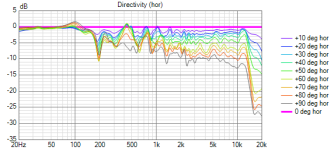
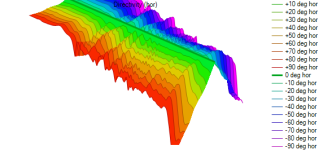
With DXT serial cap (or dsp) correction should go very high up to 15kHz.
OK, how about stealing wg+tweeters from JBL LSR305 actives? 😊 https://www.erinsaudiocorner.com/loudspeakers/jbl_305pmk2/
My MkI:


Last edited:
Perhaps the dullness reported with DXT comes from "too even" directivity added with low H3? We are used to have dome-typical rising on-axis response associated with rising DI. With DXT this peak is missing, so eg. cymbals with lots of harmonic overtones are not so crispy. As well it is rare to see as smooth response above 10kHz with add-on waveguides.
Good points overall but I cannot agree, at least based on my experience with other low H3 tweeters + WG. Additionally, the dullness I talked about is the lack of the details, certain laziness. It is not the dullness in the positive meaning, not like calm, laid back, etc as these could be actually positive attributes of the percieved sound.
Correct....soft domes have a hard time with those crisp dynamic edges of sounds in a complex mix........as an engineer i struggle with getting that content there with monitors......but when i put on a set of phones?......it's all there. And if we substitute distortions for it, we're likely at the point of power compression anyways so everything suffers......except in the case of a CD.
For in room, it's been my experience that nothing beats a true ribbon tweeter here........CDs can do that too.......but they introduce other issues lower in frequency. Metal domes can do it......but then there's the break up.
I've never done it but i often wonder what a true ribbon crossed over very high to say a 1.2" dome might work?...........sometimes what we actually hear and enjoy is far different than what we look at on paper or (sans inappropriate comparison that screams toxic masculinity)
I'll add one last time because it's noteworthy for the OP......the REAL struggle is going to be the presentation of that mid dome.........no matter the accompaniment.....it's gonna stand out like an odd ball contestant in a Thai beauty pageant (couldn't resist)
For in room, it's been my experience that nothing beats a true ribbon tweeter here........CDs can do that too.......but they introduce other issues lower in frequency. Metal domes can do it......but then there's the break up.
I've never done it but i often wonder what a true ribbon crossed over very high to say a 1.2" dome might work?...........sometimes what we actually hear and enjoy is far different than what we look at on paper or (sans inappropriate comparison that screams toxic masculinity)
I'll add one last time because it's noteworthy for the OP......the REAL struggle is going to be the presentation of that mid dome.........no matter the accompaniment.....it's gonna stand out like an odd ball contestant in a Thai beauty pageant (couldn't resist)
Fountek NeoCD3.5H at least has crisp treble, but narrowish dispersion. Actually I liked them very much, but they didn't match with AINOgradient's overall sound. I still have two pairs of them...
https://www.audioexcite.com/?page_id=4178

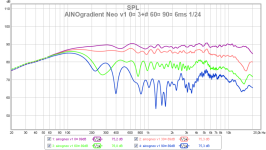
https://www.audioexcite.com/?page_id=4178

Thank you for this insight. I have been a bit suspicious of the shape of the DXT waveguide, namely that it has sharp-edged discontinuities. This is not a feature I see on other well-designed waveguides. I don't see this feature on your waveguides, or Augerpro's, or the waveguides of SBA Satori, Revel, Neumann, or Dutch & Dutch.The DXT creates directivity by introducing intentional diffraction. It has a property that I would try and avoid when desigining a waveguide
Another tweeter I am seriously considering is the Bliesma T25A. Based on the simulations, I think the directivity with a 3k crossover in this baffle would be acceptable without a waveguide. However, a waveguide might allow some fine-tuning of the directivity to optimize this parameter.
Have you ever looked at a T25A waveguide?
Yevgeniy has waveguides for Bliesmas, but not for alus..
https://hificompass.com/en/projects/horn/waveguide-wg104-xx/25-bliesma-t25b-6-t25d-6-t25s-6-tweeters
https://hificompass.com/en/projects/horn/waveguide-wg104-xx/34-bliesma-t34b-4-t34d-4-tweeter
https://hificompass.com/en/projects/horn/waveguide-wg104-xx/25-bliesma-t25b-6-t25d-6-t25s-6-tweeters
https://hificompass.com/en/projects/horn/waveguide-wg104-xx/34-bliesma-t34b-4-t34d-4-tweeter
Yeah, he seems dislike aluminum drivers in general. We all hear things a little differently, and I have not had a bad experience with any aluminum driver: SB17NBAC/CAC, SB15NBAC/CAC, SB26CDC, Dayton RS225, Dayton RS270, the old Vifa D25AG-35.Yevgeniy has waveguides for Bliesmas, but not for alus..
By the way, thanks to everyone for the discussion on the SEAS DXT tweeter.
https://www.somasonus.net/bliesma-t25bHave you ever looked at a T25A waveguide?
Not sure how close the shape of the AL dome is to the BE.
Last edited:
I have used the DXT several times now and like it very much, when the characteristics of the tweeter match the concept. I also failed the first time to implement it successfully in a passive three way and gave up after some time - but it was related to my lack of experience, you must think a bit different with this tweeter also with the xo filter. I did comparison of DXT vs. TAC/GB in a 3-way speaker - the TAC/GB w/o Waveguide has more "sparkle" and the DXT sounds more "boring", but I perceive this as more neutral and more long-time enjoyable as nothing stands out, less speaker sound. TAC/GB is more "spectacular" which makes also much fun to listen, but is less neutral.
I also like the T25A very much, it's the best hard dome I have worked with till now. Sound is very open, dry and neutral, capable to reproduce high dynamic SPL peaks for the tiny size. Dome ringing can be treated with a notch in series too, but the frequency is so high and the motor so good that this is not really necessary. The very wide dispersion leads to a "bright" treble that reminds me of a good ribbon, and that might match the assumed sonical characteristics of the M74A well. At least this would be my personal choice.
The T25A has another dome geometry than the other T25x variants and resulting a wider dispersion >10kHz. This leads to issues with waveguides and their common given entry diameters of > 1". Tweeters that have more directivity > 10kHz avoid reflections in the entry WG geometry and show better behaviour. This is the reason why there are no WGs for the T25A available, it's the wrong tweeter for this kind of application. If you want more narrow dispersion and/ or WG, take another tweeter. The T25A is made to be used flush mount for very low directivity.
I also like the T25A very much, it's the best hard dome I have worked with till now. Sound is very open, dry and neutral, capable to reproduce high dynamic SPL peaks for the tiny size. Dome ringing can be treated with a notch in series too, but the frequency is so high and the motor so good that this is not really necessary. The very wide dispersion leads to a "bright" treble that reminds me of a good ribbon, and that might match the assumed sonical characteristics of the M74A well. At least this would be my personal choice.
The T25A has another dome geometry than the other T25x variants and resulting a wider dispersion >10kHz. This leads to issues with waveguides and their common given entry diameters of > 1". Tweeters that have more directivity > 10kHz avoid reflections in the entry WG geometry and show better behaviour. This is the reason why there are no WGs for the T25A available, it's the wrong tweeter for this kind of application. If you want more narrow dispersion and/ or WG, take another tweeter. The T25A is made to be used flush mount for very low directivity.
Last edited:
- Home
- Loudspeakers
- Multi-Way
- High Performance 3-way based on Bliesma M74A
